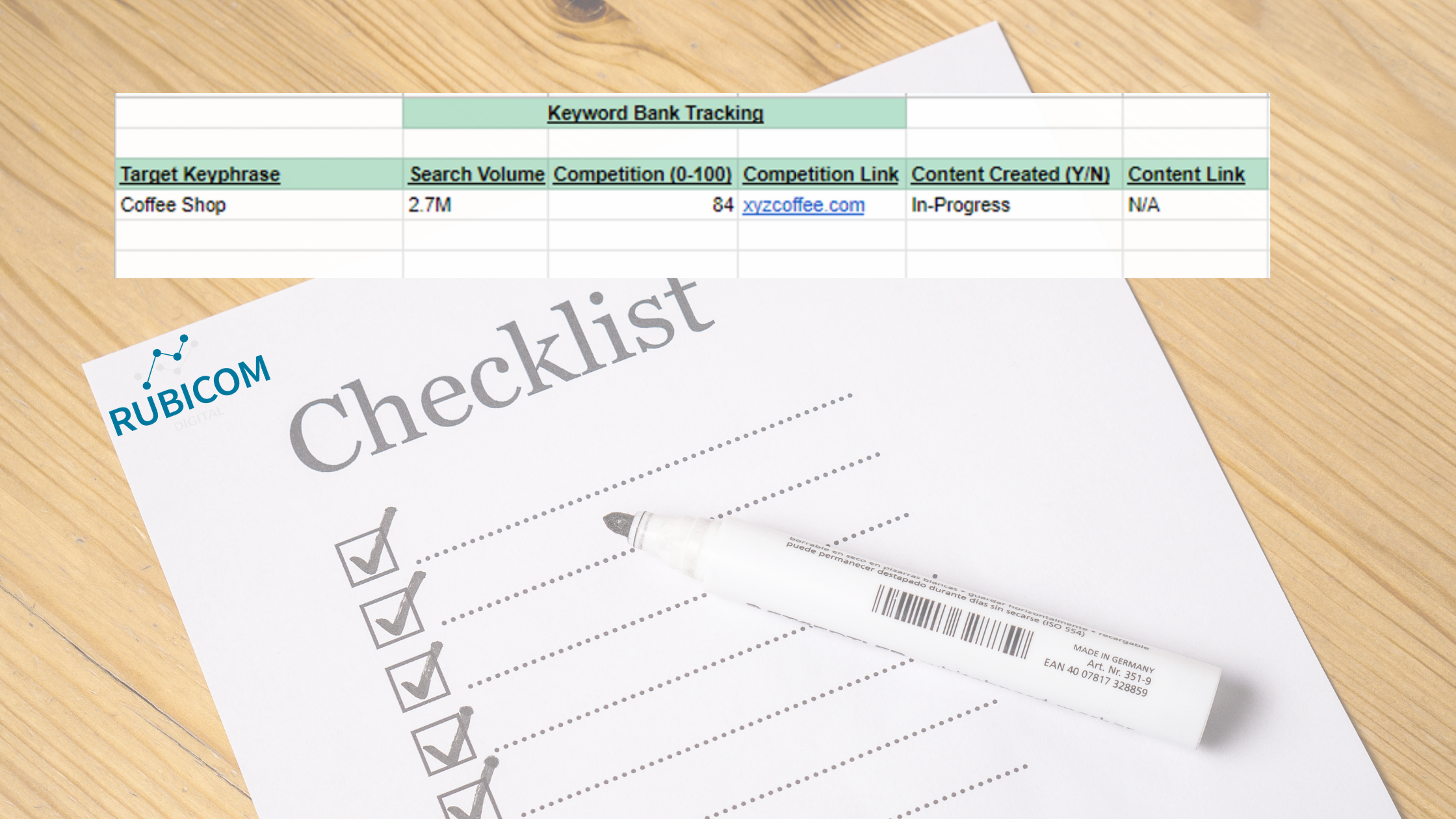Why You Should Build a Keyword List for SEO
With the theme over the past few weeks consisting of planning for the year ahead, let’s take some time this week to dive into how to build a keyword list for SEO (search engine optimization).
Your ultimate goal is to drive valuable traffic to your website and convert visitors to customers, but there are a number of reasons you’ll want to build a list including:
- Helps with your planning efforts
- Enables you to better understand your audience
- Enables you to better understand competitors
- Provides topics to help drive content strategy
- Last but certainly not least, helps your business work its way up the rankings within search engines to enhance your overall visibility.
As you go through this topic, we’ll talk about each stage of getting started with building your list, and how building that keyword list will better serve your planning and strategy for the upcoming year.
How to Get Started on Building a Keyword List
Grab an Excel or Google Sheet in order to track your keywords (we’ll talk about how to structure that sheet once we have some keywords added to it).
The first way to get started is by simply brainstorming. With a baseline understanding of your industry and the value that it provides to your target audience, you’ll be able to come up with a few ideas on which keywords and keyphrases your audience might be searching for.
Once you have compiled a list of targeted keywords, it’s time to use a keyword research tool to determine:
- Monthly search volume of the keyword/keyphrases
- Competitor analysis to determine which keywords/keyphrases your competitors are targeting
- Variants of the keywords/keyphrases and/or additional keywords that you didn’t think of
Your list should include both:
- Keywords: keywords are much more broad. ‘Coffee’ is a broad keyword that will expose you to a wide array of audience. These are great, but will take a significant amount of work to rank for as you’re competing with the top players in the industry for them.
- Keyphrases/long-tail keywords: these are the recommended targets to start as they’re much more narrow and expose your organization to a more niche end user. As an example, rather than targeting ‘coffee’ for a keyword, you’ll leverage a keyphrase that targets ‘coffee shops near me’. *keyphrases typically include 3-5 word phrases
Here’s what using the keyword research tool might look like; this specifical example is powered by SEMrush.
In this example we’re looking at data for the term ‘coffee shops’. By the looks of this keyphrase, it receives 2.7 Million searches per month but has a keyword difficulty of 84%, meaning it will be incredibly difficult to rank for based on the competition that is already out there for this phrase.
The percentages above show the SEMrush breakdown on how easy/difficult it will be to rank for a word. The sweet spot is a combination of higher search volume but less competition as you strive to target a niche market.
Because this keyword has such high competition, we can look at keyword variations, questions, and related questions to look for easier phrases to rank for, and ultimately add them to the compiled keyword list for SEO that we’re building.
As the tool allows you to generate new ideas, you’ll also be able to gain insight on what keywords and phrases that your competitors are targeting.

The same information that we just accessed for the term ‘coffee shops’, we can gain from competitor analysis to better understand which words they’re targeting.
You can then target keywords and phrases that your competitors are going after in hopes of taking away some of their traffic and driving those users to your site instead.
Keep in mind that Starbucks is an industry leader with a strong foothold which will make it difficult to directly compete with, so we’d recommend going after more local competition to start, and then expand as you get the hang of it.
However, the great part about search engine optimization is that even smaller organizations can compete within working their way up the search engines as long as they’re producing quality content for their audience.
With this analysis, you should have a much better idea of what keywords make sense for your business to target in the upcoming year.
Now we’ll go through how to structure all of the insight that we just gathered so that it’s easy to track progression over time.
How to Structure Your Keyword List for SEO
You more than likely have more than enough keywords within your sheet now, so now you can optimize the sheet into what we call a ‘Keyword Bank’ in order to track the targeting progress.
The keyword bank is broken into 6 sections:
- Target keyphrase: the keyword or keyphrase that you’re going after.
- Search volume: monthly search volume provided by the keyword research tool.
- Competition level: defined from 0-100 based on the insight from the keyword research tool that you’re using. You’ll want to target both high, medium, and low competition depending on how valuable the word or phrase is to your business.
- Competition link: this link is defined as one of the top 3 competitors that come up when searching for the targeted phrase. By tracking the valuable links, it’ll give you an idea of the type of quality that your content will need to have in order to rank for the term.
- Content creation: this tells you whether or not you’ve developed content yet to go after the desired keyphrase.
- Content link: once the content has been created, track the links to the content.
This list should be continually updated as you identify more keywords that you want to target; Ensure they’re tailored around what will drive the most value to your target audience, as well as your business.
After your list is compiled with data behind all of your targets, it’ll now become much easier to deploy a content strategy as you’ve already built the foundation of it.
Driving Content Strategy and Execution
Your keywords and keyphrases directly correlate with the value that your business offers your target audience. Now the only thing left to do is deliver quality content to your audience in order to highlight that value. This will be a lot of work, but it becomes much easier now that you’ve built the structure behind your content.
By building out your keyword list for SEO, you’re able to track all of the terms that you’d like your website to rank for, and then in turn create and optimize content around those targets.
Continuously track your progress by checking off the keywords that you’ve created content for.
Keep in mind that just because you’ve completed a piece of content, you’re never actually done with it. Focus on continuously optimizing your pieces in order to ensure that you’re increasing your rankings for that targeted keyword or keyphrase.
Lastly, leverage a number of marketing channels such as:
- Video (YouTube)
- Text (Blog)
- Voice (Podcast)
- Visual (Infographics/whitepapers)
Not all users prefer to consume their content the same way, so leveraging different channels allows you to still use the keyword list for SEO that you’ve built, while reaching a larger audience.
Let us know how your keyword list is coming along for the upcoming year or if you need help building one!

Gary McConnell Co-founded Rubicom Digital in 2019 with a goal of providing digital marketing consulting services in the B2B space.
Gary continues to serve as the Marketing Director of a Data Center-focused IT Provider, VirtuIT Systems.

